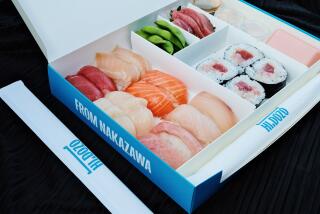At Last, the Raw Truth About a Hidden Danger of Sushi
When Judy Sakanari heads out to a sushi restaurant to indulge a craving for her favorite food, she takes two things with her: a ravenous appetite and a flashlight.
The appetite needs no explanation; the flashlight is so Sakanari, a UC San Francisco parasite researcher, can carefully examine the raw fish--especially in dimly lit sushi bars--before she eats it. It is a precaution against getting a disease she and other researchers say has quietly begun posing a threat to sushi-loving Americans.
“The more you know,” Sakanari says, “the more you want to just be careful.”
At issue is confirmation of rumors that have been making the rounds of sushi and sashimi aficionados for years: Yes, researchers say, there really is a little worm in some raw fish that can make diners recall the worst stomach aches of their lives as comparatively pleasurable experiences.
The disorder--a parasitic infection called anisakiasis--until now has been little known in the United States. Sakanari and Dr. James McKerrow, a sushi-loving UC San Francisco pathologist, have published a brief study of it in today’s New England Journal of Medicine. An Alabama-based U.S. Food and Drug Administration health worker collaborated.
Although Japan reports more than 1,000 cases a year, anisakiasis was unknown in this country before 1958, they say. Even now, only 50 cases are on record here, more than 70% of them reported since 1980.
But with evolution of the sushi and sashimi craze, Sakanari said, the American rate is probably significantly greater than published figures indicate. UC San Francisco doctors have treated three acute cases in the last year alone, at just one hospital.
Ironically, according to Sakanari and McKerrow, the sushi parasite has become a particularly difficult problem on the West Coast, at least in part because populations of native marine mammals--especially the California sea lion--have flourished as a result of protective laws.
The worm--called a nematode--responsible for anisakiasis exists symbiotically in the food chain on which the mammals feed. As the sea lion has staged a comeback to population levels not seen since the 19th Century, the sushi parasite has established a beachhead of its own. McKerrow said marine mammals eat fish infected by the parasite, which the fish have acquired from small invertebrate organisms.
Diners can avoid the parasite by carefully selecting a sushi bar. Sushi chefs trained in Japan are routinely taught to detect evidence of the parasite in fish they buy and serve, said Sakanari and McKerrow.
Hisashi Yoshiara, the Japanese-trained chef at Cafe Jacoulet in Pasadena, said a chef should be able to assure diners that the sushi bar purchases its fish whole, not already cut up. He said only fish of so-called sushi quality --the whole fresh fish has clear, glassy eyes, completely intact scales and a healthy pink color to the gills--should be served. Yoshiara contended that American sushi chef training does not yet provide sufficient awareness of parasite risks.
For the sushi fan unwilling to entirely trust his or her health to the restaurant, Sakanari suggested a close visual inspection of the fish you are served. She said the half-inch worm, which is usually white but may take on other hues, can often be seen with the naked eye.
There is some disagreement over which fish species may be especially susceptible to problems with anisakiasis. McKerrow and Sakanari advised steering clear of red snapper and salmon in favor of octopus and tuna. But Yoshiara said his experience teaches that halibut is especially risky, with swordfish sometimes a problem, too.
For someone unlucky enough to eat fish contaminated with the anisakiasis worm, a great deal of unpleasantness may be in store. Sometimes the parasite can be felt in the esophagus within 24 hours after a meal--a sensation called tingling throat syndrome . If this occurs, said Sakanari, coughing may be effective.
If the parasite gets into the digestive tract, it can produce symptoms often confused for appendicitis--intense abdominal pain, nausea, vomiting, fever and diarrhea. Some victims have mistakenly undergone appendectomies before the true nature of the problem was discovered. The worm may bore through the intestine, further complicating the situation.
Drugs have no effect, though the parasite sometimes dies in the digestive tract and passes from the body. But for patients who are not so lucky, a surgeon must often be called in--first to try to find the worm in the intestines using a fiber-optic device called an endoscope and, if that fails, by performing major abdominal surgery to cut away the affected section of intestine.
Sakanari said UC San Francisco recently treated a sushi victim who came to the hospital complaining of ulcer symptoms. An examination with an endoscope was ordered, during which the physician unexpectedly came upon the parasite and was able to remove it.
Both Sakanari and McKerrow concede that, though they have intimate acquaintance with the consequences, their own devotion to sushi and sashimi has been undeterred by their discoveries.
“I must say I’m staying away from salmon now and leaning more to octopus and tuna,” McKerrow said. “But I’ll tell you, I still eat sushi.
“I have an emotional attachment to this research.”






